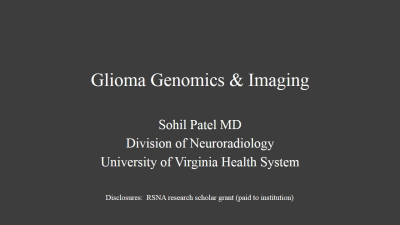Weekend Educational Session
Gliomas
Session Topic: Gliomas
Session Sub-Topic: Gliomas
Weekend Course
ORGANIZERS: Meiyun Wang, Rajan Jain
| Saturday Parallel 3 Live Q&A | Saturday, 8 August 2020, 15:00 - 15:30 UTC | Moderators: Meiyun Wang & Harish Poptani |
Skill Level: Basic to Advanced
Session Number: WE-22
Overview
This course will tackle glioma biology and genomics, WHO classification update, and diagnosis--including standard of care and advanced imaging techniques, surveillance imaging, and treatment.
Target Audience
Neuroradiologists, neurooncologists, neurosurgeons, medical physicists, and imaging scientists at various levels will benefit from participating in this session.
Educational Objectives
As a result of attending this course, participants should be able to:
- Explain glioma biology and genomics as well as WHO classification update;
- Describe advanced imaging techniques for diagnosis;
- Demonstrate surveillance imaging, therapy response assessment, and follow up; and
- Discuss treatment paradigm shift/s.
| Preclinical Imaging
Arvind Pathak
|
||
 |
Glioma Genomics & Imaging
Sohil Patel
The World Health Organization classifies adult diffuse gliomas by integrating prognostically relevant molecular biomarkers with histopathologic features. Molecular biomarkers integrated in the classification include isocitrate dehydrogenase gene mutation and chromosome 1p/19q codeletion. For high grade gliomas / glioblastomas, MGMT promoter hypermethylation confers overall survival benefit and greater sensitivity to alkylating chemotherapy agents. Among pediatric gliomas, histone H3 mutations associate with high grade gliomas, and MAP kinase pathway alterations associate with low grade gliomas. Neuroimaging-based biomarkers can non-invasively predict underlying glioma genomic status and furthermore may add clinical value to the current classification scheme.
|
|
| MR Imaging for Diagnosis & Surveillance
Pia Maly Sundgren
In this presentation present and future imaging modalities including CEST imaging to grade brain tumor and to evaluate and differentiate between treatment response and tumor recurrence will be presented. The focus will be on MRI but also additional imaging strategies such as PET imaging and the combined value of different imaging strategies will be discussed. Scientific evidence and clinical practical cases will be presented. The advantages and disadvantages of imaging methods will be discussed.
|
||
 |
Radiomics in Glioma
Ji Eun Park
This lecture aims at providing insight into radiomics to become a viable tool for glioma patients. Recent radiogenomics studies and methodologic improvements of radiomics as diagnostic, prognostic, and/or predictive biomarkers will be described. A concept of tumor heterogeneity and subregional radiomics will also be introduced.
|
|
| Presurgical fMRI: Task-Based & Resting-State
Ho-Ling Liu
|
||
| MR/PET/MRS for Guiding Radiotherapy
Georges El Fakhri
|
||
| Image Guided Neurosurgery
Wei Chieh Chang
The efficacy and effectiveness of MRgFUS in Taiwanese population, of Asian ethnicity, has not yet been studied extensively. It has been shown that the clinical characteristics of ET and the skull factors might differ in Asians from Caucasians. The main objective of this study is to evaluate outcome of MRgFUS in terms of tremor suppression and adverse events in Taiwanese patients with refractory tremor.
|
||
| What Is on the Horizon: CEST
Linda Knutsson
A relatively new field of MRI is Chemical Exchange Saturation Transfer (CEST). In this talk basic principles of CEST MRI will be introduced and several examples will be presented to illustrate the potential of using CEST for clinical diagnosis and prognosis in gliomas.
|

 Back to Program-at-a-Glance
Back to Program-at-a-Glance Watch the Video
Watch the Video Back to Top
Back to Top